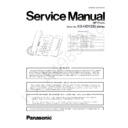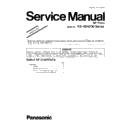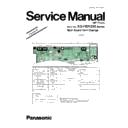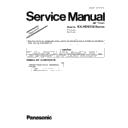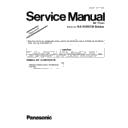Read Panasonic KX-HDV230RU Service Manual online
ORDER NO. KMS1508151CE
SIP Phone
Model No.
KX-HDV230
Series
[ Version 4.0 ]
Ver.No
Model No.
Destination
1
KX-HDV230NE KX-HDV230NEB Europe
KX-HDV230B
KX-HDV230
USA
KX-HDV230CB
-----------
Canada
KX-HDV230X
KX-HDV230XB
Asia,Africa and Other area
-----------
KX-HDV230SXB India
White Version
Black Version
2
KX-HDV230A
-----------
Belgium
3
KX-HDV230RUB
KX-HDV230RU
Russia, Ukraine, Kazakhstan
4
2
KX-HDV230 Series
TABLE OF CONTENTS
PAGE
PAGE
1 Safety Precautions -----------------------------------------------3
1.1. For Service Technicians ---------------------------------3
2 Warning --------------------------------------------------------------3
2.1. Information for Users on Collection and
Disposal of Old Equipment and used Batteries-----3
2.2. About Lead Free Solder (PbF: Pb free) --------------4
2.2.1. Suggested PbF Solder -------------------------------4
2.3. Discarding of P. C. Board --------------------------------4
3 Specifications ------------------------------------------------------5
4 Technical Descriptions------------------------------------------6
4 Technical Descriptions------------------------------------------6
4.1. Block Diagram ----------------------------------------------6
4.2. Circuit Operations ------------------------------------------7
4.2. Circuit Operations ------------------------------------------7
4.2.1. Main LCD Circuit --------------------------------------7
4.2.2. Self Label LCD Circuit--------------------------------7
4.2.3. Reset Circuit --------------------------------------------8
4.2.4. Ethernet Circuit ----------------------------------------9
4.2.5. PoE Circuit -------------------------------------------- 10
4.2.6. Analog Circuit ---------------------------------------- 10
4.2.7. Key Circuit--------------------------------------------- 12
4.2.8. LED Circuit -------------------------------------------- 13
4.2.9. ASIC ---------------------------------------------------- 14
4.2.2. Self Label LCD Circuit--------------------------------7
4.2.3. Reset Circuit --------------------------------------------8
4.2.4. Ethernet Circuit ----------------------------------------9
4.2.5. PoE Circuit -------------------------------------------- 10
4.2.6. Analog Circuit ---------------------------------------- 10
4.2.7. Key Circuit--------------------------------------------- 12
4.2.8. LED Circuit -------------------------------------------- 13
4.2.9. ASIC ---------------------------------------------------- 14
4.2.10. Power Supply Circuit ------------------------------- 14
5 Location of Controls and Components------------------ 15
5.1. Name and Locations ------------------------------------ 15
6 Installation Instructions--------------------------------------- 19
6.1. Connections ----------------------------------------------- 19
7 Test Mode ---------------------------------------------------------- 20
7.1. Peer to Peer Test Mode -------------------------------- 20
7.1.1. Preparation-------------------------------------------- 20
7.1.2. Connection for Test --------------------------------- 21
7.1.3. Communication Test -------------------------------- 21
7.1.4. Quit peer to peer Test mode ---------------------- 21
7.1.2. Connection for Test --------------------------------- 21
7.1.3. Communication Test -------------------------------- 21
7.1.4. Quit peer to peer Test mode ---------------------- 21
7.2. Functional Test Mode ----------------------------------- 22
7.2.1. Preparation-------------------------------------------- 22
7.2.2. Functional Test mode lists------------------------- 22
7.2.3. Quit this Test Mode --------------------------------- 23
7.2.2. Functional Test mode lists------------------------- 22
7.2.3. Quit this Test Mode --------------------------------- 23
8 Service Mode ----------------------------------------------------- 24
8.1. Factory Setting-------------------------------------------- 24
8.1.1. How to Clear User Setting ------------------------ 24
8.2. How to Change MAC Address
Label(Procedure after Replacing the Main
P.C.B.)------------------------------------------------------- 24
P.C.B.)------------------------------------------------------- 24
8.2.1. Replacing Main P.C.B. ----------------------------- 24
8.2.2. Attaching MAC Address Label ------------------- 25
8.2.2. Attaching MAC Address Label ------------------- 25
9 Troubleshooting Guide---------------------------------------- 26
9.1. No Operation ---------------------------------------------- 26
9.1.1. Power ON Error-------------------------------------- 26
9.1.2. Power Supply : AC adaptor ----------------------- 26
9.1.3. Power Supply : PoE -------------------------------- 27
9.1.2. Power Supply : AC adaptor ----------------------- 26
9.1.3. Power Supply : PoE -------------------------------- 27
9.2. LCD Does Not Operate --------------------------------- 31
9.2.1. MAIN LCD Not Operate---------------------------- 31
9.2.2. Self-Label Not Operate ---------------------------- 32
9.2.2. Self-Label Not Operate ---------------------------- 32
9.3. Handset Does Not work -------------------------------- 33
9.3.1. Receive ------------------------------------------------ 33
9.3.2. Send ---------------------------------------------------- 33
9.3.2. Send ---------------------------------------------------- 33
9.4. Headset Does Not work -------------------------------- 34
9.4.1. Receive ------------------------------------------------ 34
9.4.2. Send ---------------------------------------------------- 34
9.4.2. Send ---------------------------------------------------- 34
9.5. Speaker-Phone Does Not work ---------------------- 35
9.5.1. Receive------------------------------------------------ 35
9.5.2. Send---------------------------------------------------- 35
9.5.2. Send---------------------------------------------------- 35
9.6. EHS does not work(EHS control signal) ----------- 36
9.7. Ethernet Does Not work ------------------------------- 37
9.7. Ethernet Does Not work ------------------------------- 37
9.7.1. L2SW Date error ------------------------------------ 37
9.7.2. LAN port----------------------------------------------- 38
9.7.3. PC port ------------------------------------------------ 38
9.7.2. LAN port----------------------------------------------- 38
9.7.3. PC port ------------------------------------------------ 38
9.8. LED Does Not Light ------------------------------------- 39
10 Disassembly and Assembly Instructions -------------- 40
10.1. Remove Main Board and Selflabel Board --------- 40
10.2. Assembly for Lead wire -------------------------------- 41
10.2. Assembly for Lead wire -------------------------------- 41
10.2.1. Connecting Lead Wires --------------------------- 41
11 Maintenance------------------------------------------------------ 43
11.1. Terminal Guide of the ICs Transistors and
Diodes ------------------------------------------------------ 43
11.1.1. Main Board ------------------------------------------- 43
11.1.2. LED Board -------------------------------------------- 43
11.1.3. Selflabel Board -------------------------------------- 44
11.1.2. LED Board -------------------------------------------- 43
11.1.3. Selflabel Board -------------------------------------- 44
11.2. How To Replace a Flat Package IC ----------------- 45
11.2.1. Preparation ------------------------------------------- 45
11.2.2. Removal Procedure -------------------------------- 45
11.2.3. Procedure--------------------------------------------- 45
11.2.4. Removing Solder From Between Pins--------- 45
11.2.2. Removal Procedure -------------------------------- 45
11.2.3. Procedure--------------------------------------------- 45
11.2.4. Removing Solder From Between Pins--------- 45
12 Schematic Diagram -------------------------------------------- 46
12.1. Main Board ------------------------------------------------ 46
12.1.1. No. 1 --------------------------------------------------- 46
12.1.2. No. 2 --------------------------------------------------- 47
12.1.3. No. 3 --------------------------------------------------- 48
12.1.4. No. 3 --------------------------------------------------- 49
12.1.5. No. 5 --------------------------------------------------- 50
12.1.2. No. 2 --------------------------------------------------- 47
12.1.3. No. 3 --------------------------------------------------- 48
12.1.4. No. 3 --------------------------------------------------- 49
12.1.5. No. 5 --------------------------------------------------- 50
12.2. Back Light Board----------------------------------------- 51
12.3. Selflabel Board ------------------------------------------- 52
12.4. Waveform -------------------------------------------------- 53
12.3. Selflabel Board ------------------------------------------- 52
12.4. Waveform -------------------------------------------------- 53
12.4.1. No.(1)-(8)---------------------------------------------- 53
12.4.2. No.(9)-(16) -------------------------------------------- 54
12.4.3. No.(17)-(24) ------------------------------------------ 55
12.4.4. No.(25)-(29) ------------------------------------------ 56
12.4.2. No.(9)-(16) -------------------------------------------- 54
12.4.3. No.(17)-(24) ------------------------------------------ 55
12.4.4. No.(25)-(29) ------------------------------------------ 56
13 Printed Circuit Board------------------------------------------ 57
13.1. Main Board ------------------------------------------------ 57
13.1.1. Component View ------------------------------------ 57
13.1.2. Bottom View ------------------------------------------ 58
13.1.2. Bottom View ------------------------------------------ 58
13.2. Back Light Board----------------------------------------- 59
13.3. LCD Board and LED Board --------------------------- 59
13.4. Selflabel Board ------------------------------------------- 60
13.3. LCD Board and LED Board --------------------------- 59
13.4. Selflabel Board ------------------------------------------- 60
13.4.1. Component View ------------------------------------ 60
13.4.2. Bottom View ------------------------------------------ 61
13.4.2. Bottom View ------------------------------------------ 61
14 Appendix Information of Schematic Diagram -------- 62
15 Exploded View and Replacement Parts List----------- 63
15 Exploded View and Replacement Parts List----------- 63
15.1. Cabinet and Electric Parts----------------------------- 63
15.2. Accessories and Packing Materials ----------------- 64
15.3. Replacement Parts List -------------------------------- 66
15.2. Accessories and Packing Materials ----------------- 64
15.3. Replacement Parts List -------------------------------- 66
15.3.1. Cabinet and Electrical Parts---------------------- 66
15.3.2. Accessories and Packing Materials ------------ 67
15.3.3. Main Board Parts ----------------------------------- 67
15.3.4. Selflabel Board Parts ------------------------------ 72
15.3.5. LED Board Parts ------------------------------------ 72
15.3.2. Accessories and Packing Materials ------------ 67
15.3.3. Main Board Parts ----------------------------------- 67
15.3.4. Selflabel Board Parts ------------------------------ 72
15.3.5. LED Board Parts ------------------------------------ 72
3
KX-HDV230 Series
1 Safety Precautions
1. Before servicing, unplug the AC power cord to prevent an electric shock.
2. When replacing parts, use only the manufacturer's recommended components.
3. Check the condition of the power cord. Replace if wear or damage is evident.
4. After servicing, be sure to restore the lead dress, insulation barriers, insulation papers, shields, etc.
5. Before returning the serviced equipment to the customer, be sure to perform the following insulation resistance test to prevent
2. When replacing parts, use only the manufacturer's recommended components.
3. Check the condition of the power cord. Replace if wear or damage is evident.
4. After servicing, be sure to restore the lead dress, insulation barriers, insulation papers, shields, etc.
5. Before returning the serviced equipment to the customer, be sure to perform the following insulation resistance test to prevent
the customer from being exposed to shock hazards.
1.1.
For Service Technicians
• Repair service shall be provided in accordance with repair technology information such as service manual so as to prevent fires,
injury or electric shock, which can be caused by improper repair work.
1. When repair services are provided, neither the products nor their parts or members shall be remodeled.
2. If a lead wire assembly is supplied as a repair part, the lead wire assembly shall be replaced.
3. FASTON terminals shall be plugged straight in and unplugged straight out.
2. If a lead wire assembly is supplied as a repair part, the lead wire assembly shall be replaced.
3. FASTON terminals shall be plugged straight in and unplugged straight out.
• ICs and LSIs are vulnerable to static electricity.
When repairing, the following precautions will help prevent recurring malfunctions.
1. Cover plastic parts boxes with aluminum foil.
2. Ground the soldering irons.
3. Use a conductive mat on worktable.
4. Do not grasp IC or LSI pins with bare fingers.
2. Ground the soldering irons.
3. Use a conductive mat on worktable.
4. Do not grasp IC or LSI pins with bare fingers.
2 Warning
2.1.
Information for Users on Collection and Disposal of Old Equipment and
used Batteries
used Batteries
4
KX-HDV230 Series
2.2.
About Lead Free Solder (PbF: Pb free)
Note:
In the information below, Pb, the symbol for lead in the periodic table of elements, will refer to standard solder or solder that
contains lead.
contains lead.
We will use PbF solder when discussing the lead free solder used in our manufacturing process which is made from Tin (Sn),
Silver (Ag), and Copper (Cu).
Silver (Ag), and Copper (Cu).
This model, and others like it, manufactured using lead free solder will have PbF stamped on the PCB. For service and repair
work we suggest using the same type of solder.
work we suggest using the same type of solder.
Caution
• PbF solder has a melting point that is 50 °F ~ 70 °F (30 °C ~ 40 °C) higher than Pb solder. Please use a soldering iron with
temperature control and adjust it to 700 °F ± 20 °F (370 °C ± 10 °C).
• Exercise care while using higher temperature soldering irons.:
Do not heat the PCB for too long time in order to prevent solder splash or damage to the PCB.
• PbF solder will tend to splash if it is heated much higher than its melting point, approximately 1100 °F (600 °C).
• When applying PbF solder to double layered boards, please check the component side for excess which may flow onto the
• When applying PbF solder to double layered boards, please check the component side for excess which may flow onto the
opposite side (See the figure below).
2.2.1.
Suggested PbF Solder
There are several types of PbF solder available commercially. While this product is manufactured using Tin, Silver, and Copper,
(Sn+Ag+Cu), you can also use Tin and Copper, (Sn+Cu), or Tin, Zinc, and Bismuth, (Sn+Zn+Bi). Please check the manufac
turer's specific instructions for the melting points of their products and any precautions for using their product with other
materials.
The following lead free (PbF) solder wire sizes are recommended for service of this product: 0.3mm, 0.6mm and 1.0mm.
(Sn+Ag+Cu), you can also use Tin and Copper, (Sn+Cu), or Tin, Zinc, and Bismuth, (Sn+Zn+Bi). Please check the manufac
turer's specific instructions for the melting points of their products and any precautions for using their product with other
materials.
The following lead free (PbF) solder wire sizes are recommended for service of this product: 0.3mm, 0.6mm and 1.0mm.
2.3.
Discarding of P. C. Board
When discarding P. C. Board, delete all personal information such as telephone directory and caller list or scrap P. C. Board.

